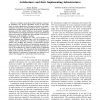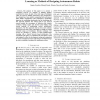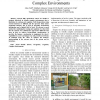ROMAN
2007
IEEE
14 years 5 months ago
2007
IEEE
— The paper presents an approach to intelligent, interactive people following for autonomous robots. The approach combines robust methods for simultaneous localization and mappin...
IROS
2007
IEEE
14 years 5 months ago
2007
IEEE
— Complex, autonomous robots integrate a large set of sometimes very diverse algorithms across at least three levels of system organization: the agent architecture, the implement...
CEC
2007
IEEE
14 years 5 months ago
2007
IEEE
—The purpose of this paper is to present a comparison between two methods of building adaptive controllers for robots. In spite of the wide range of techniques which are used for...
IROS
2009
IEEE
14 years 6 months ago
2009
IEEE
—Current fully autonomous robots are unable to navigate effectively in visually complex environments due to limitations in sensing and cognition. Full teleoperation using current...
HRI
2009
ACM
14 years 6 months ago
2009
ACM
Autonomous robots tend to induce the perception of a personality through their behavior and appearance. It has been suggested that the personality of a robot can be used as a desi...



